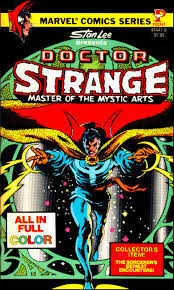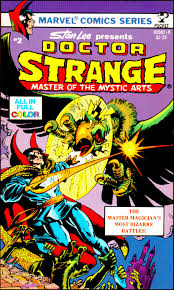
In an earlier post, I shared my interest in Black Bolt, leader of the Inhumans. Another Marvel character I've always admired is Dr. Strange. As you may know, Dr. Strange (like Spider-Man) was created by Stan Lee and (the notoriously reclusive) Steve Ditko.
 Dr. Strange first appeared in the aptly named Strange Tales #110 (July 1963).
Dr. Strange first appeared in the aptly named Strange Tales #110 (July 1963). Strange is... a world-renowned if selfish neurosurgeon, until a car accident damages his hands and prevents him from conducting surgery. Learning of a hermit called the Ancient One who might cure his condition, Strange finds the man in the Himalayas. After Strange selflessly tries to thwart a traitorous disciple (Baron Mordo), the Ancient One teaches Strange the mystic arts.Trekking to a wise man in the Himalayas -- where have we heard that one before? In fact, Dr. Strange is like a catalog of '60s preoccupations: the occult, Eastern mysticism, mind-bending (though not drug-induced) dimensions.
Steve Ditko drew the feature through Strange Tales #146 (July 1966), and during this period he and Lee introduced many of Strange's allies, such as his eventual lover Clea; and his enemies Nightmare; Baron Mordo; and Dormammu. Ditko also visualized the cosmic entity Eternity, a sometime ally of Strange.
These stories revealed that Strange uses magical artifacts to augment his power, such as the Cloak of Levitation; Eye of Agamotto; Book of the Vishanti and the Orb of Agamotto. From the first story, Strange's residence, the Sanctum Sanctorum, was a part of the character's mythos. The trademark circular window divided by three sweeping lines on the front of the residence (actually the protective Seal of the Vishanti) appears in many Doctor Strange stories. Strange's personal servant, Wong, guards the residence in his absence.

(The Sanctum Sanctorum always reminded me of Rotwang's lab in Metropolis.)
After Ditko ended his spectacular run, the good doc suffered through a period of creative lethargy. He was resuscitated in 1968 when artist Gene Colan came aboard.



As you can see, not only the title but the character himself got a facelift. In his stint on the book, Colan also drew one of the more famous covers in comics:

Unfortunately, Dr. Strange was canceled with issue #183 (Nov. 1969). His next notable appearance came three years later:
The character was showcased in the title Marvel Premiere with one story marking the debut of another of Strange's recurring foes, the entity Shuma-Gorath. To stop Shuma-Gorath entering reality, Strange is forced to shut down the Ancient One's mind, which causes his physical death. The Ancient One, however, assures Strange this was a necessary sacrifice and his soul merges with the cosmic entity Eternity. Strange then assumes the title of Sorcerer Supreme.Writer Steve Engelhart and artist Frank Brunner produced a string of stellar issues.



(Engelhart was responsible for some wildly purple prose including "His dirt-filled mouth will scream forever in hideous agony.")
Dr. Strange got his own animated movie a couple years ago; ergo, I was able to introduce the character to my daughter. What better to pass from generation to generation? Now if I could only bequeath the All-seeing Eye of Agamotto...


No comments:
Post a Comment